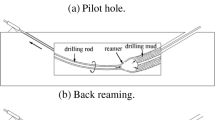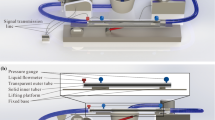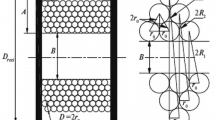Abstract
Lost circulation is one of the most troublesome and costly problems encountered in drilling. This problem is magnified while drilling in deeper, depleted and complex reservoirs. Based on the nation of preventive treatment, the paper intends to present a novel hydraulic tool with a purpose of lost circulation control while drilling. The hydraulic energy of swirling jet is employed in this tool to push the granules in drilling fluid into the fractures, and “an artificial borehole wall” is formed to enhance the pressure-bearing capacity of leakage formation. Moreover, a computing model for flow rate allocation of the tool is developed. The result of comparison experiment on plugging effectiveness manifests that plugging effectiveness with the use of hydraulic tool is much better than that without the tool. The maximal pressure-bearing capacity of experimental core is increased to 8.3 MPa under the experimental circumstances, which demonstrates that the hydraulic tool can provide an effective preventive treatment for lost circulation. Furthermore, field tests of the hydraulic tool are conducted in deep wells and depleted reservoirs. The statistical results validate that the plugging effectiveness can be improved greatly by employing the tool, and the pressure-bearing capacity of formation in depleted reservoir is increased to 11.6 MPa.
Similar content being viewed by others
Abbreviations
- LCM:
-
Lost circulation material
- WSM:
-
Well-strengthening material
- BHA:
-
Bottom hole assembly
- ROP:
-
Rate of penetration
- RFT:
-
Repeat formation test
- \(Q_{s}\) :
-
Flow rate of rig pump (L/s)
- \(Q_{b}\) :
-
Flow rate of drill bit (L/s)
- \(Q_{c}\) :
-
Flow rate of swirling jet nozzles (L/s)
- I :
-
Flow rate ratio
- \(p_b\) :
-
Pressure drop of drill bit and hydraulic tool (MPa)
- \(p_s\) :
-
Rig pump pressure (MPa)
- \(K_L\) :
-
Circulating pressure loss coefficient
- L :
-
Well depth (m)
- \(\xi \) :
-
Coefficient of local resistance
- \(\gamma \) :
-
Unit weight of drilling fluid \((\hbox {N/m}^{3})\)
- \(v_e\) :
-
Equivalent jet velocity of drill bit nozzles and swirling jet nozzles (m/s)
- g :
-
Acceleration of gravity (N/kg)
- C :
-
Discharge coefficient of nozzle
- \(d_e\) :
-
Equivalent diameter of drill bit nozzles and swirling jet nozzles (cm)
- \(A_0\) :
-
Total equivalent area of nozzles \((\hbox {cm}^{2})\)
- \(\rho _w\) :
-
Density of drilling fluid \((\hbox {g/cm}^{3})\)
- \(d_{{\textit{ej}}}\) :
-
Equivalent diameter of bit nozzles (cm)
- \(d_f\) :
-
Equivalent diameter of hydraulic energy distribution device (cm)
- \(d_c\) :
-
Equivalent diameter of swirling jet nozzles (cm)
- \(v_c\) :
-
Jet velocity of swirling jet nozzle (m/s)
- \(p_c\) :
-
Pressure drop of hydraulic tool (MPa)
- \(v_j\) :
-
Jet velocity of drill bit nozzles (m/s)
- \(F_j\) :
-
Impact force of drill bit jet (kN)
- \(N_{{\textit{bj}}}\) :
-
Hydraulic horsepower of drill bit (kW)
- \(F_c\) :
-
Impact force of swirling jet (kN)
- \(N_c\) :
-
Hydraulic horsepower of hydraulic tool (kW)
- \(v_{{\textit{pc}}}\) :
-
The ROP (m/h)
- n :
-
Rotation speed of drill string (rpm)
- A :
-
Action area of each swirling jet nozzle \((\hbox {m}^{2})\)
- R :
-
Radius of well bore (m)
References
Nayberg, T.M.: Laboratory study of lost circulation materials for use in both oil-based and water-based drilling muds. SPE Drill. Eng. 2(3), 229–236 (1987). doi:10.2118/14723-PA
Alsabagh, A.M.; Abdou, M.I.; Khalil, A.A.; Ahmed, H.E.; Aboulrous, A.A.: Investigation of some locally water-soluble natural polymers as circulation loss control agents during oil fields drilling. Egypt. J. Petrol. 23(1), 27–34 (2014). doi:10.1016/j.ejpe.2014.02.005
Calçada, L.A.; Neto, O.A.D.; Magalhães, S.C.; Scheid, C.M.; Filho, M.N.B.; Waldmann, A.T.A.: Evaluation of suspension flow and particulate materials for control of fluid losses in drilling operation. J. Petrol. Sci. Eng. 131, 1–10 (2015). doi:10.1016/j.petrol.2015.04.007
Rajnauth, J.: Is it time to focus on unconventional resources. Adv. Petrol. Explor. Dev. 4(2), 37–45 (2012). doi:10.3968/j.aped.1925543820120402.778
Oort, E.V.; Friedheim, J.E.; Pierce, T.; Lee, J.: Avoiding losses in depleted and weak zones by constantly strengthening wellbores. SPE Drill. Complet. 26(4), 519–530 (2011). doi:10.2118/125093-MS
Xu, C.Y.; Kang, Y.L.; You, L.J.; Li, S.; Chen, F.: High-strength high-stability pill system to prevent lost circulation. SPE Drill. Complet. 29(3), 334–343 (2013). doi:10.2118/172496-PA
Romero, S.N.; Monroy, R.R.; Johnson, C.; Cardenas, F.; Abraham, G.A.T.: Preventing lost circulation using lightweight slurries with reticular systems: depleted reservoirs in southern Mexico. Presented at SPE international petroleum conference in Mexico, Puebla Pue, Mexico, 7–9 November (2004). doi:10.2118/92187-MS
Caughron, D.E.; Renfrow, D.K.; Bruton, J.R.; Ivan, C.D.; Broussard, P.N.; Bratton, T.R.; Standifird, W.B.: Unique crosslinking pill in Tandem with fracture prediction model cures circulation losses in deepwater gulf of Mexico. Presented at IADC/SPE drilling conference, Dallas, Texas, 26–28 February (2002). doi:10.2118/74518-MS
Papadimitriou, N.I.; Romanos, G.E.; Charalambopoulou, G.C.; Kainourgiakis, M.E.; Katsaros, F.K.; Stubos, A.K.: Experimental investigation of asphaltene deposition mechanism during oil flow in core samples. J. Petrol. Sci. Eng. 57(3–4), 281–293 (2007). doi:10.1016/j.petrol.2006.10.007
Verret, R.; Robinson, B.; Cowan, J.; Fader, P.; Looney, M.: Use of micronized cellulose fibers to protect producing formations. Presented at SPE international symposium on formation damage control, Lafayette, Louisiana, 23–24 February (2000). doi:10.2118/58794-MS
Otutu, F.: Novel wellbore strengthening enables drilling of exploration well in a highly depleted formation. Presented at SPE/IADC middle east drilling technology conference and exhibition, Muscat, Oman, 24–26 October (2011). doi:10.2118/148506-MS
Davidson, E.; Richardson, L.; Zoller, S.: Control of lost circulation in fractured limestone reservoirs. Presented at IADC/SPE Asia pacific drilling technology, Kuala Lumpur, Malaysia, 11–13 September (2000). doi:10.2118/62734-MS
Alberty, M.W.; Mclean, M.R.: A physical model for stress cages. Presented at SPE annual technical conference and exhibition, Houston, Texas, 26–29 September (2004). doi:10.2118/90493-MS
Goud, M.C.; Josep, J.: Drilling fluid additives and engineering to improve formation integrity. Presented at SPE/IADC Indian drilling technology conference and exhibition, Mumbai, India, 16–18 October (2013). doi:10.2118/104002-MS
Alberty, M.W.; McLean, M.R.: Fracture gradients in depleted reservoirs—drilling wells in late reservoir life. Presented at SPE/IADC drilling conference, Amsterdam, Netherlands, 27 February (2001). doi:10.2118/67740-MS
Aston, M.S.; Alberty, M.W.; Duncum, S.D.; Bruton, J.R.; Friedheim, J.E.; Sanders, M.W.: A new treatment for wellbore strengthening in shale. Presented at SPE annual technical conference and exhibition, Anaheim, California, U.S.A, 11–14 November (2007). doi:10.2118/110713-MS
Dupriest, F.E.; Smith, M.V.; Zeilinger, S.C.; Shoykhet, N.: Method to eliminate lost returns and build integrity continuously with high-filtration-rate fluid. Presented at IADC/SPE drilling conference, Orlando, Florida, USA, 4–6 March (2008). doi:10.2118/112656-MS
Wang, H.; Soliman, M.Y.; Towler, B.F.: Investigation of factors for strengthening a wellbore by propping fractures. SPE Drill. Complet. 24(3), 441–451 (2009). doi:10.2118/112629-PA
Van Oort, E.; Razavi, O.S.: Wellbore strengthening and casing smear: the common underlying mechanism. Presented at ADC/SPE drilling conference and exhibition, Fort Worth, Texas, USA, 4–6 March (2014). doi:10.2118/168041-MS
Traugott, D.A.; Sweatman, R.E.; Vincent, R.A.: Increasing the wellbore pressure containment in gulf of Mexico HP/HT wells. SPE Drill. Complet. 22(1), 16–25 (2007). doi:10.2118/96420-PA
Kostov, N.; Gosavi, S.V.; Kulkarni, K.; Dasari, G.: Fracture modeling for optimum wellbore integrity enhancement. Presented at Abu Dhabi international petroleum exhibition and conference, Abu Dhabi, UAE, 7–10 November (2016). doi:10.2118/183325-MS
Ghalambor, A.; Salehi, S.; Shahri, M.P.; Karimi, M.: Integrated workflow for lost circulation prediction. Presented at SPE international symposium and exhibition on formation damage control, Lafayette, Louisiana, USA, 26–28 February (2014). doi:10.2118/168123-MS
Yuan, E.X.: Engineering Fluid Mechanics. Petroleum Industry Press, Beijing (1986)
Whittaker, A.: Theory and Application of Drilling Fluid Hydraulics. IHRDC Press, Boston (1985)
Author information
Authors and Affiliations
Corresponding author
Rights and permissions
About this article
Cite this article
Qin, D., Xiong, J. & Wang, G. A Novel Hydraulic Tool for Lost Circulation Control While Drilling with Improved Plugging Effectiveness. Arab J Sci Eng 43, 2581–2592 (2018). https://doi.org/10.1007/s13369-017-2879-2
Received:
Accepted:
Published:
Issue Date:
DOI: https://doi.org/10.1007/s13369-017-2879-2




